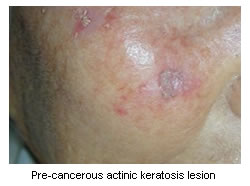Actinic Keratosis
Actinic keratosis is a pre-cancerous spot on
the skin. In some instances, these spots turn into squamous cell
carcinoma, a form of skin cancer.

Symptoms of Actinic Keratosis
- Rough spots that feel like "sandpaper"
- Reddish in color
- Small in size, a third to a half inch in diameter
These spots absorb liquid or powder cosmetic foundations differently
than the rest of the skin. This tends to make even cosmetic application
difficult - indeed, many women discover that they have actinic
keratosis while applying cosmetics.
Who Gets Actinic Keratosis?
Although anyone can develop actinic keratosis, the most susceptible
people are those with fair, white skin who has frequent sun exposure
or who have sun-damaged skin.
This condition usually develops in people in their 30s, although
it can sometimes develop in young adults and teenagers.
Prevention
Actinic keratosis and other sun-damage to the skin can be avoided
by:
- Limiting the exposure to the sun
- Wearing protective clothings and hats
- Using lotion with high SPF (sun protection factor)
Is it Cancer?
No, actinic keratosis is not a cancer. However, they are a result
of sun damage and may indicate greater risk of skin cancer in
these areas.
People with actinic keratosis should examine their spots every
month.
Actinic Keratosis Treatment?
Actinic keratosis treatments are:
- Cryotherapy or freezing with liquid nitrogen
- Topical cream with 5-fluorouracil
- Chemical and laser peels
ActinicKeratosesNet
- Online reference on actinic keratosis
Gallery
of Actinic Keratosis


